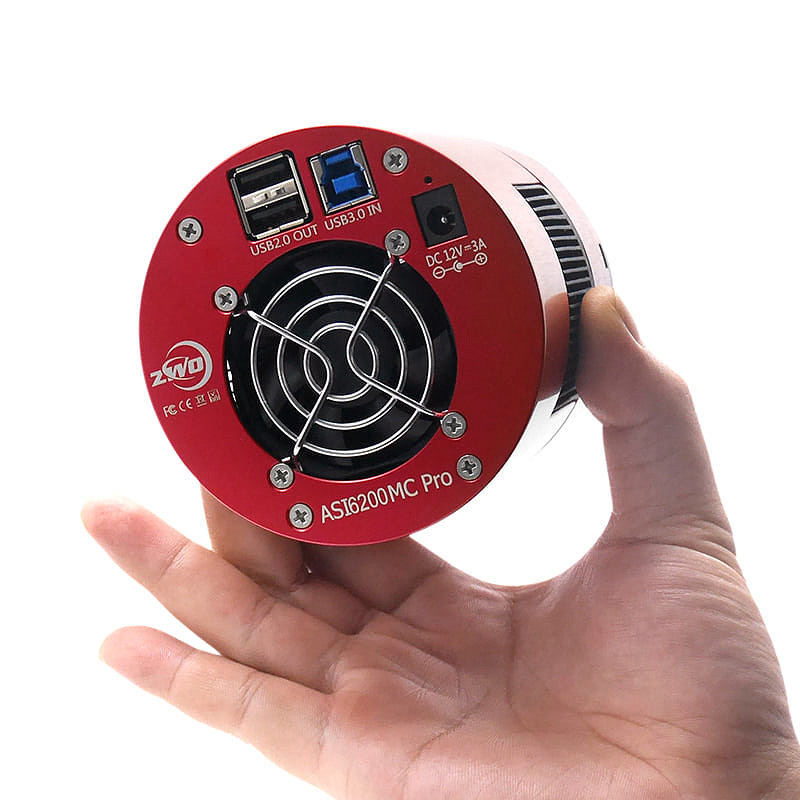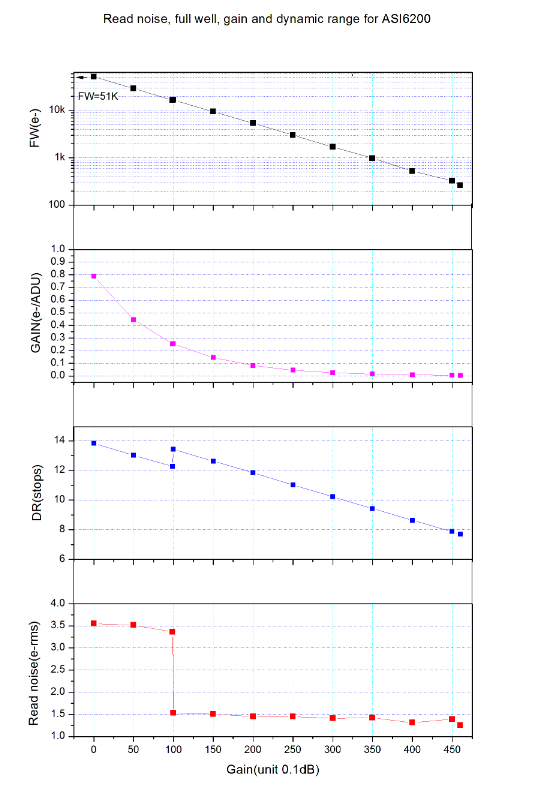Sensor: SONY IMX455 CMOS
Diagonal: 43.3mm
Resolution: 62 Mega Pixels 9576*6388
Pixel Size: 3.76μm
Bayer Pattern: None
Shutter: Rolling shutter
Exposure Range: 32μs-2000s
ROI: Supported
Read Noise: 1.5-3.5e
QE peak: over 80%
Full well: 50000e
ADC:16bit
DDRIII Buffer: 256MB
Non-volatile memory/On camera storage: Build-in total 192K byte user-accessible space(image size up to 480X320)
Interface: USB3.0/USB2.0
Interface: USB3.0/USB2.0
Adapter: M42X0.75
Protect window: D60-AR Coating
Dimensions: 90mm Diameter
Weight: 700g
Back Focus Distance: 17.5mm
Cooling: Regulated Two Stage TEC
Delta T: 35°C-35°C below ambient
Camera Power consumption: 650mA at 5V
Cooler Power consumption: 12V at 3A Max
Working Temperature: -5°C—45°C
Storage Temperature: -20°C—60°C
Working Relative Humidity: 20%—80%
Storage Relative Humidity: 20%—95%
Max FPS at full resolution:
16Bit ADC
9576×6388 3.19fps
7680×4800 5.29fps
6400×4096 7.44fps
4096×2160 14.35fps
3840×2160 14.35fps
1920×1080 28.04fps
1280×720 41.12fps
640×480 59.67fps
320×240 108.72fps
more resolutions are in software, support customize resolution.
Hai bisogno di informazioni sul prodotto?
Description
ASI6200 - A 16bit Color FullFrame!
The new ZWO ASI6200MC camera is the first camera in the world to use the Sony ExMor IMX455 sensor.
This new Sony sensor is the first sensor for astronomical cameras to use the 16bit FullFrame format
Unlike its smaller sister ASI094, this new camera has a back-illuminated sensor (BSI) which allows it to reach QE of up to 80% and new levels of gray scales previously unimaginable thanks to the new 16bit sensor, which is far more powerful !

Exceptional low-light performance SNR1s: 0.14lx
This is achieved by using a large optical system and expanding the area per pixel to 3.76 microns; which makes the IMX455 sensor ideal for astronomical applications where high performance is required even at low illumination.
%20ZWO%20ASI.png)
SONY 61.2MP sensor with 43.2 mm diagonal
The SONY IMX455 sensor has a diagonal of 43.2 mm and 3.76x3.76 micron pixels, the FULLFRAME format is a new, even more performing sensor, with 61.2MP and a resolution of 9600x6400.
With this sensor it is possible to photograph an entire cluster of galaxies and show the details of each one at the same time!
The chamber also features TEC Cooling with a thermal delta of the ambient temperature up to -40°.

Technical features:
Two-stage regulation with thermal delta of 40° compared to the environment
Electronic shutter: no vibration
Extremely low read noise: 1.0e @24db gain 3.3e @lowest gain
16bit ADC: provide real 16bit Dynamic range
USB 3.0: Ultra-high frame download speed, avoids data loss during download
USB 2.0 HUB: Double USB 2.0 port useful for connecting the driving camera
Window with AR coated
Telescope side thread: M54x0.75
Compatible with Windows-Mac-Linux
Backfocus: 17.5mm

256MB DDR3 internal memory so you don't miss any frames!
Thanks to the brand new 256MB DDR3 internal memory you will not lose any information even via the USB 2.0 outputs!

FULL WELL HUGE CAPACITY!
The new ASI6200 is capable of reaching a Full Well Capacity of 51000e!
Even bright stars do not saturate with long exposures!
This camera can achieve higher SNR (signal to noise ratio) with just one exposure.


16 Bit CMOS
The new ASI6200 features a 16bit Sony CMOS sensor, thanks to this new technology we obtain a better dynamic range scale

AMP Glow? No thank you!
Unlike other cameras, the ASI6200 has completely eliminated any kind of AMP Glow of the sensor
This is a 300 second frame, as you can see, there is no AMP Glow

Anti-condensation system integrated in the chamber

Comparison between ASI6200 and KAI11002 - CMOS vs CCD
Why choose a CCD when you can use a new CMOS back-illuminated sensor for higher performance?

How do I get 55mm backfocus?
Here is a simple diagram on how to get 55mm of backfocus with our ASI6200

Technical features

What's in the box?
In addition to the accessories listed below, Artesky is giving away a power supply to use the camera.

Payment and security
Your payment information is processed securely. We do not store credit card details nor have access to your credit card information.






